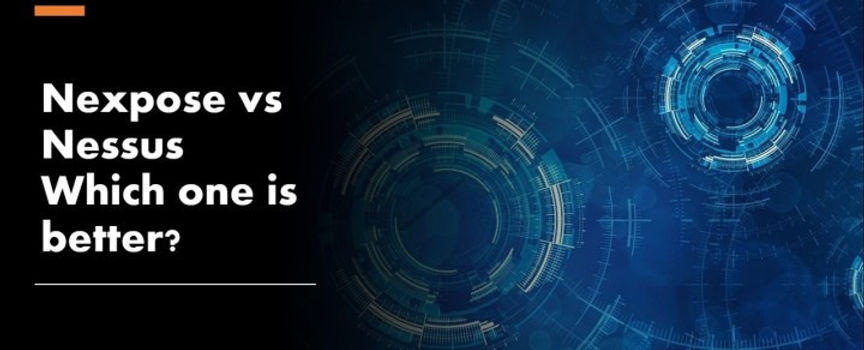
Nessus VS Nexpose:
Nessus and Nexpose are two of the popular vulnerability assessment and management tools used by organizations to scan networks, identify vulnerabilities, and improve security posture. While both serve similar purposes, they have differences in features, usability, and performance.
Here's a detailed comparison of Nessus and Nexpose

1. Vendor and Product Overview
Nessus: Developed by Tenable, Nessus is a widely used vulnerability scanner focused on identifying vulnerabilities, configuration issues, and malware across different environments (on-premise, cloud, and hybrid). It is part of a larger suite offered by Tenable.io for comprehensive vulnerability management.
Nexpose: Developed by Rapid7, Nexpose is a vulnerability management tool that provides real-time visibility into network vulnerabilities and risk prioritization based on asset criticality and exposure.
2. User Interface and Usability
Nessus: Nessus is known for its clean and simple user interface. It offers detailed reports and vulnerability insights but may require more manual intervention in certain areas like report customization and prioritization.
Nexpose: Nexpose has an intuitive interface, especially when integrated with the InsightVM platform, which offers an advanced dashboard for real-time data, risk prioritization, and trend analysis. The integration with other Rapid7 tools like Metasploit makes it highly versatile for security professionals.
3. Scanning Capabilities
Nessus:
Performs network-based, agent-based, and web application scanning.
Scans a wide variety of devices and platforms (Linux, Windows, cloud, etc.).
Offers compliance checks, malware detection, and configuration auditing.
Has a rich library of vulnerability plugins that are frequently updated.
Nexpose:
Offers robust network-based and agent-based scanning.
Features Adaptive Security, which allows dynamic, real-time scanning based on network changes.
Focuses on real-time exposure and risk scoring (based on Rapid7’s RealRisk™ metric).
Scans for vulnerabilities across physical, cloud, and virtual environments.
4. Vulnerability Coverage and Updates
Nessus: Tenable regularly updates Nessus with new vulnerability checks, plugins, and compliance templates. It has one of the largest vulnerability databases in the industry and provides detailed information on each detected vulnerability.
Nexpose: Nexpose provides constant updates to its vulnerability database and integrates with threat intelligence feeds. It also uses CVE, CVSS, and its own RealRisk™ metric to assess vulnerabilities based on criticality and likelihood of exploitation.
5. Risk Scoring and Prioritization
Nessus: Nessus mainly relies on CVSS (Common Vulnerability Scoring System) for vulnerability risk scores. It does not provide native risk prioritization based on asset criticality unless paired with Tenable.io or Tenable.sc.
Nexpose: Nexpose uses a RealRisk™ score that incorporates CVSS but also factors in exploit availability, malware kits, and asset criticality to prioritize the most critical risks. This provides more context-based prioritization for remediation efforts.
6. Integration and Ecosystem
Nessus: Nessus is often deployed as part of the broader Tenable ecosystem (Tenable.io or Tenable.sc) for enterprise-grade vulnerability management. It also integrates with SIEMs, ticketing systems, and other security tools but is somewhat less integrated into pentesting tools.
Nexpose: Nexpose integrates natively with Rapid7’s Insight Platform (InsightVM) and Metasploit for penetration testing, remediation tracking, and automation. Its ecosystem is broader, making it a powerful tool for vulnerability management when combined with other Rapid7 solutions.
7. Compliance and Reporting
Nessus: Nessus provides a wide range of pre-built compliance reports (PCI DSS, HIPAA, etc.). Users can generate detailed reports based on scan results, but customization options may be limited without using other Tenable products.
Nexpose: Nexpose/InsightVM has excellent reporting and dashboarding capabilities. It allows for more customized, visual reports and integrates with ticketing systems for better remediation tracking. It also supports compliance templates for various regulations (e.g., PCI, CIS).
8. Performance and Scalability
Nessus: Nessus is lightweight and known for its fast scanning speeds. It is suitable for smaller environments and scales reasonably well, especially when combined with Tenable.io for larger environments.
Nexpose: Nexpose scales efficiently across large enterprise environments, especially with its agent-based architecture. The tool’s ability to scan in real-time and adapt to changing environments gives it an edge in larger, more dynamic networks.
9. Pricing and Licensing
Nessus: Nessus is available as Nessus Essentials (free for small networks, up to 16 IPs), Nessus Professional (paid version with unlimited IP scanning), and as part of Tenable.io. Nessus Professional is suitable for small to mid-sized organizations, while Tenable.io is more suitable for larger enterprises.
Nexpose/InsightVM: Nexpose is available as part of the InsightVM platform. Pricing is typically based on the number of assets scanned. InsightVM provides additional features, including cloud and container security, and is aimed at larger enterprises.
10. Customer Support and Community
Nessus: Tenable offers good support for Nessus Professional users, but community support for the free version (Nessus Essentials) is limited. Paid users get access to premium support services.
Nexpose: Rapid7 offers strong support for Nexpose/InsightVM users, including extensive documentation, forums, and premium support services. The community is also quite active, especially with Metasploit integration.
11. Automation and Remediation
Nessus: Nessus provides automation options for scanning, but remediation tracking is more basic. For full automation, including remediation workflows, Nessus is best used with Tenable.io.
Nexpose: Nexpose/InsightVM excels in automation, particularly with features like Automated Containment and Remediation Workflows that allow IT teams to streamline patch management and incident response.
12. Agent vs Agentless
Nessus: Nessus offers both agent-based and agentless scanning. The agent-based approach is useful for scanning endpoints that are not always on the network.
Nexpose: Nexpose/InsightVM also offers agent-based and agentless scanning, but its Insight Agent is designed for continuous, real-time scanning of assets, making it highly efficient for large and dynamic environments.
Summary of Key Differences:
Feature | Nessus | Nexpose/InsightVM |
Vendor | Tenable | Rapid7 |
User Interface | Simple and clean | Advanced, integrated with InsightVM |
Risk Scoring | CVSS-based | RealRisk™ + CVSS |
Integration | Good with SIEM, ticketing, and Tenable | Excellent with Rapid7 products (Metasploit) |
Reporting | Detailed but limited customization | Customizable, real-time dashboards |
Compliance | PCI, HIPAA, and others | Extensive, customizable templates |
Automation | Limited (stronger with Tenable.io) | Strong automation (remediation, containment) |
Pricing | Free for limited use (Nessus Essentials), Professional version for unlimited | Based on the number of assets |
Best for | Small to medium-sized organizations | Large enterprises, dynamic environments |
The Final Statement:
Nessus is a widely recognized and reliable choice for organizations seeking a user-friendly yet powerful vulnerability scanner. It offers a straightforward approach that does not require extensive integration or automation efforts, making it ideal for businesses looking for a quick and efficient solution to enhance their security posture.
Nexpose/InsightVM brings a more comprehensive approach to vulnerability management, particularly tailored for enterprises with complex security needs. Its strength lies in its ability to seamlessly integrate with other security tools, providing real-time risk prioritization capabilities that help organizations stay ahead of emerging threats. Moreover, its advanced reporting and automation features empower businesses to streamline their security operations and respond proactively to potential risks.




